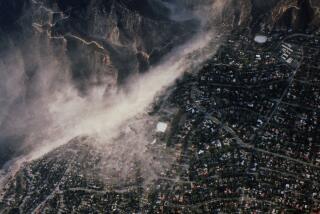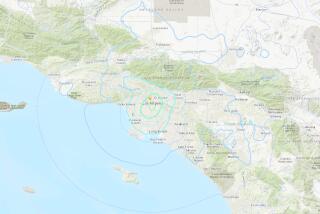Chile reels from 8.8 earthquake
Reporting from Bogota, Colombia â One of the biggest earthquakes in recorded history rocked Chile on Saturday, killing more than 300 people, toppling buildings and freeways, and setting off sirens thousands of miles away as governments scrambled to protect coastal residents from the ensuing tsunami.
FOR THE RECORD:
Chilean quake: An article in the Feb. 28 Section A about the earthquake in Chile said its epicenter was relatively deep. The article should have described that point of origin as the hypocenter, or focus; the epicenter is the section of Earthâs surface directly above a temblorâs point of origin. â
Chilean President Michelle Bachelet declared parts of the country âcatastrophe zonesâ in the wake of the magnitude 8.8 quake, which was centered offshore, about 70 miles north of the port city of Concepcion.
With images of Haitiâs devastation from an earthquake last month still fresh, the world woke up to a new disaster and fears of another catastrophic toll. But the Chile quakeâs epicenter was relatively deep, at 21.7 miles, and building codes are strict in a country that 50 years ago was struck by the biggest earthquake ever recorded: a magnitude 9.5.
Nonetheless, Bachelet said in an address to the nation Saturday night that a million buildings had been damaged. And with television stations showing topsy-turvy structures, severed bridges and highways whose pavement looked as if it had been tilled by some giant farm machine, the death toll was expected to rise.
Concepcion resident Alberto Rozas said his building began to shake and he grabbed his daughter in terror amid shattering glass and an ungodly roar.
âIt was awful,â said Rozas, who lives next to a 15-story apartment building that was reduced to rubble. âThe only thing I did right was throw clothes on the floor so my daughter and I could escape without ruining our feet. But weâre still covered with cuts.â
As a flurry of 30 aftershocks, some measuring greater than magnitude 6.0, continued to strike the region all day, Chileâs Interior Ministry said tsunami surges reaching heights of 10 feet hit the nationâs Juan Fernandez Islands, leaving three people dead and 13 missing.
Memories of the tsunami that was unleashed on Southeast Asia and around the Indian Ocean five years ago haunted governments across the Pacific on Saturday. In Hawaii, 100,000 people were evacuated to higher ground, and the U.S. Navyâs Pacific Fleet sent four warships out to sea as a precaution against damage near shore at Pearl Harbor.
A series of small 3-foot tsunamis hit Hawaiiâs Big Island shortly after 1 p.m., churning up sediment but causing no apparent damage. Early Sunday, Japanâs Meteorological Agency warned that a âmajorâ tsunami of up to 10 feet could hit northern coastal areas, although initial waves that reached outlying islands posed little threat.
The U.S. moved briskly to offer assistance to Chile. President Obama spoke with Bachelet to offer condolences, praising the countryâs quick response and reiterating the United Statesâ readiness to aid in rescue and recovery.
Secretary of State Hillary Rodham Clinton said she planned to visit the region Sunday. âOur hemisphere comes together in times of crisis, and we will stand side by side with the people of Chile in this emergency,â she said.
Some observers, however, worried that international relief efforts could be stretched thin by the continuing response to the Haiti earthquake, which left more than 215,000 people dead and a million homeless.
In Chile, television images showed collapsed highway overpasses and buildings in southern Santiago, the capital, and in Concepcion, 300 miles to the south. Bachelet was reported to be headed to the region to inspect the damage.
President-elect Sebastian Pinera, who will take office in two weeks, told reporters that in addition to scores of deaths, the country suffered damage to its infrastructure, including highways, airports and housing.
âThis earthquake has delivered a tremendous blow to Chilean society,â Pinera said, adding he would request emergency funds totaling 2% of the budget to help rebuild. âOur government will do everything for the recovery and to accelerate reconstruction.â
Santiagoâs international airport will be closed at least through Monday, officials said. Although the runways are in good condition, the control tower and customs facilities suffered extensive damage, officials said.
Key structures in Santiago, including ministry buildings, suffered heavy damage, said Education Minister Monica Jimenez. Government employees will be asked to stay home Monday as officials assesses structural safety, she said. Public schools that were to have reopened Monday after summer vacation are now scheduled to reopen March 8.
The quake, lasting 30 seconds or more, struck about 3:30 a.m. Saturday. Santiago residents, many of them in their pajamas, poured into the streets.
A chemical fire at a factory raged out of control and there was smoke in much of the city. Telephone service and electricity were still out in one-third of the capital as of the afternoon and communication was problematic because of the collapse of several cellphone towers.
Santiago faces possible mass transit chaos, with the cityâs subway system closed indefinitely while the tracks are inspected.
Bachelet urged drivers to not use major thoroughfares because traffic lights were out and many pedestrian bridges had collapsed.
Major damage was reported in Concepcion, the countryâs second-largest city and the one closest to the epicenter. Several fires due to gas leaks were reported. A multi-story building also collapsed.
The mayor of Concepcion, Jacqueline van Rysselberghe, described her city as âDante-esqueâ in the aftermath of the quake, saying two bridges over the Biobio River had collapsed and others were damaged. She said officials still were not sure of the death toll.
The city is home to one of the largest universities in the South American nation, Universidad de Concepcion, a public school with a decidedly liberal student body. Its grounds are often the site of socialist protests.
Kraul is a special correspondent. Times staff writers Janet Hook in Washington and Robert Faturechi in Los Angeles, and special correspondents Andres DâAlessandro in Buenos Aires and Eva Vergara and Lauren Williams in Santiago contributed to this report.
More to Read
Sign up for Essential California
The most important California stories and recommendations in your inbox every morning.
You may occasionally receive promotional content from the Los Angeles Times.










